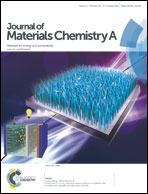Counter electrode materials combined with redox couples in dye- and quantum dot-sensitized solar cells†
Abstract
Dye- or quantum dot-sensitized solar cells (DSCs or QDSCs) comprise a sensitizer, a semiconductor, an electrolyte containing redox couple, and a counter electrode (CE), which have inspired a new wave of research. The challenges in realizing the practical application of such photovoltaic devices are the enhancement of photovoltaic performance, stability, and the reduction of fabrication costs. The CE is an important component, and the exploration of low cost CE catalysts to match the redox couples has become a feasible route in the pursuit of high power conversion efficiency and low production cost of the devices. This article reviews the development of CE catalysts for the regeneration of each type of iodide-free redox couple, including inorganic, organic, and transition metal complex-based redox couples, among others.


 Please wait while we load your content...
Please wait while we load your content...